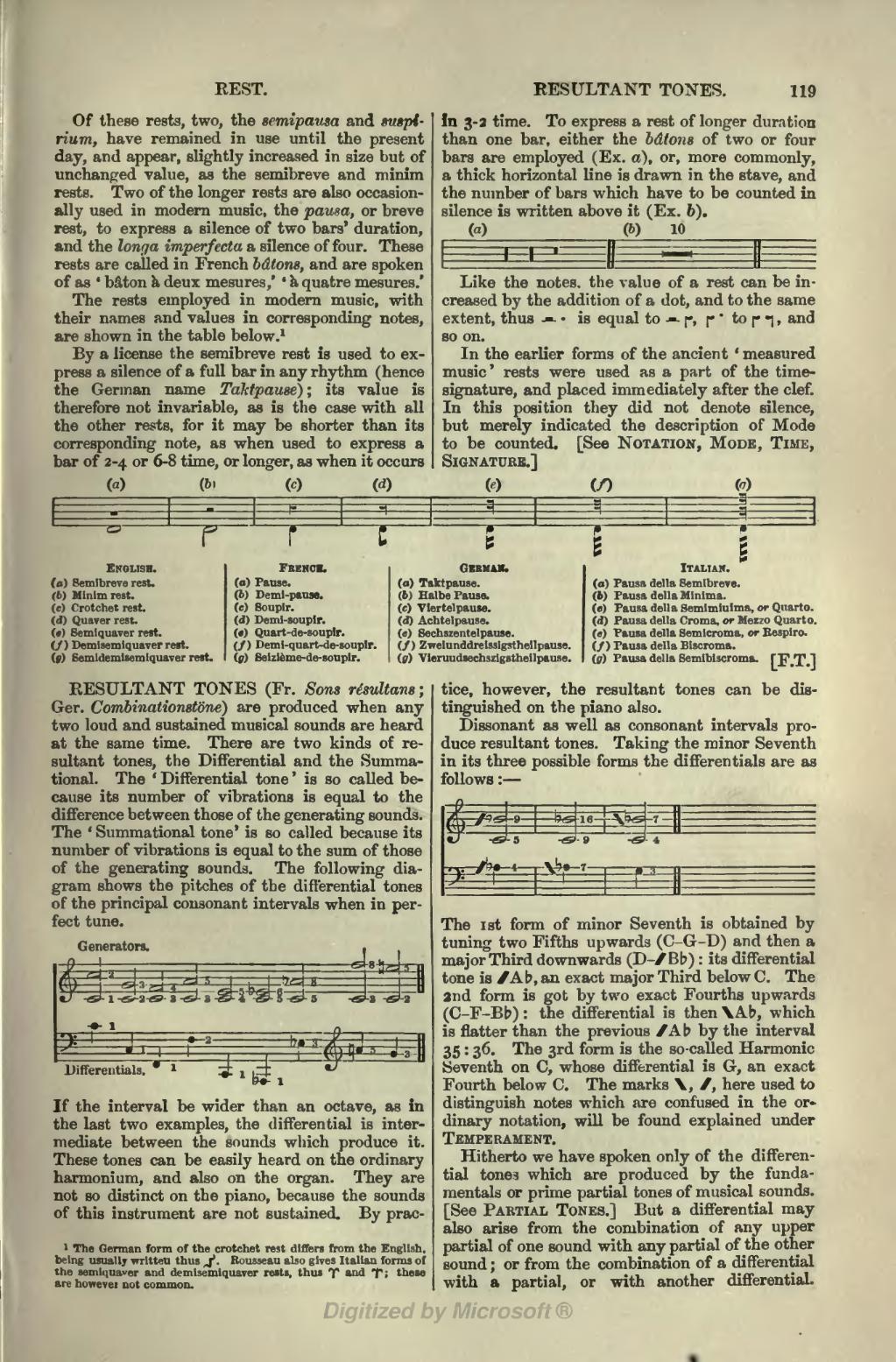Of these rests, two, the semipausa and suspirium, have remained in use until the present day, and appear, slightly increased in size but of unchanged value, as the semibreve and minim rests. Two of the longer rests are also occasionally used in modern music, the pausa, or breve rest, to express a silence of two bars' duration, and the longa imperfecta a silence of four. These rests are called in French bâtons, and are spoken of as 'bâton à deux mesures,' 'à quatre mesures.'
The rests employed in modern music, with their names and values in corresponding notes, are shown in the table below.[1]

| English. | French. | German. | Italian. |
| (a) Semibreve rest. | (a) Pause. | (a) Taktpause. | (a) Pausa della Semibreve. |
| (b) Minim rest. | (b) Demi-pause. | (b) Halbe Pause. | (a) Pausa della Minima. |
| (c) Crotchet rest. | (c) Soupir. | (c) Viertelpause. | (c) Pausa della Semiminima, or Quarto. |
| (d) Quaver rest. | (d) Demi-soupir. | (d) Achtelpause. | (d) Pausa della Croma, or Mezzo Quarto. |
| (e) Semiquaver rest. | (e) Quart-de-soupir. | (e) Sechszentelpause. | (e) Pausa della Semicroma, or Respiro. |
| (f) Demisemiquaver rest. | (f) Demi-quart-de-soupir. | (f) Zweiunddreissigstheilpause. | (f) Pausa della Biscroma. |
| (g) Semidemisemiquaver rest. | (g) Seizième-de-soupir. | (g) Vierundsechszigstehilpause. | (g) Pausa della Semibiscroma. |
By a license the semibreve rest is used to express a silence of a full bar in any rhythm (hence the German name Taktpause); its value is therefore not invariable, as is the case with all the other rests, for it may be shorter than its corresponding note, as when used to express a bar of 2–4 or 6–8 time, or longer, as when it occurs in 3-2 time. To express a rest of longer duration than one bar, either the bâtons of two or four bars are employed (Ex. a), or, more commonly, a thick horizontal line is drawn in the stave, and the number of bars which have to be counted in silence is written above it (Ex. b).
Like the notes, the value of a rest can be increased by the addition of a dot, and to the same extent, thus ![]() • is equal to
• is equal to ![]()
![]() ,
, ![]() to
to ![]()
![]() , and so on.
, and so on.
In the earlier forms of the ancient 'measured music' rests were used as a part of the timesignature, and placed immediately after the clef. In this position they did not denote silence, but merely indicated the description of Mode to be counted. [See Notation, Mode, Time, Signature.]
RESULTANT TONES (Fr. Sons résultans; Ger. Combinationstöne) are produced when any two loud and sustained musical sounds are heard at the same time. There are two kinds of resultant tones, the Differential and the Summational. The 'Differential tone' is so called because its number of vibrations is equal to the difference between those of the generating sounds. The 'Summational tone' is so called because its number of vibrations is equal to the sum of those of the generating sounds. The following diagram shows the pitches of the differential tones of the principal consonant intervals when in perfect tune.

If the interval be wider than an octave, as in the last two examples, the differential is intermediate between the sounds which produce it. These tones can be easily heard on the ordinary harmonium, and also on the organ. They are not so distinct on the piano, because the sounds of this instrument are not sustained. By practice, however, the resultant tones can be distinguished on the piano also.
Dissonant as well as consonant intervals produce resultant tones. Taking the minor Seventh in its three possible forms the differentials are as follows:—
A musical score should appear at this position in the text. See Help:Sheet music for formatting instructions |
The 1st form of minor Seventh is obtained by tuning two Fifths upwards (C-G-D) and then a major Third downwards (D-(![]() Music characters)B♭): its differential tone is (
Music characters)B♭): its differential tone is (![]() Music characters)A♭, an exact major Third below C. The 2nd form is got by two exact Fourths upwards (C-F-B♭): the differential is then (
Music characters)A♭, an exact major Third below C. The 2nd form is got by two exact Fourths upwards (C-F-B♭): the differential is then (![]() Music characters)A♭, which is flatter than the previous (
Music characters)A♭, which is flatter than the previous (![]() Music characters)A♭ by the interval 35 : 36. The 3rd form is the so-called Harmonic Seventh on C, whose differential is G, an exact Fourth below C. The marks (
Music characters)A♭ by the interval 35 : 36. The 3rd form is the so-called Harmonic Seventh on C, whose differential is G, an exact Fourth below C. The marks (![]() Music characters), (
Music characters), (![]() Music characters), here used to distinguish notes which are confused in the ordinary notation, will be found explained under Temperament.
Music characters), here used to distinguish notes which are confused in the ordinary notation, will be found explained under Temperament.
Hitherto we have spoken only of the differential tones which are produced by the fundamentals or prime partial tones of musical sounds. [See Partial Tones.] But a differential may also arise from the combination of any upper partial of one sound with any partial of the other sound; or from the combination of a differential with a partial, or with another differential.
- ↑ The German form of the crotchet rest differs from the English, being usually written thus
 . Rousseau also gives Italian forms of the semiquaver and demisemiquaver rests, thus (
. Rousseau also gives Italian forms of the semiquaver and demisemiquaver rests, thus ( Music characters) and (
Music characters) and ( Music characters); these are however not common.
Music characters); these are however not common.
